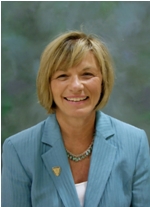
Top Performing Hospitals Reveal Their Quality Care Secrets
The Joint Commission has recognized 405 hospitals across the country as top performers on key quality measures in its annual report on quality and safety, entitled “Improving America's Hospitals.” While the leaders of those facilities indicate feeling honored and proud, for many the listing comes second to their true motivation--to improve patients’ quality of care.

Seth Torregiani, D.O., director of The Agada Center, says that alternative treatments are useful adjuncts to conventional treatment.

Marjorie Jacobs, RN, MSN, ACM, said that compliance with the quality measures is the right thing to do for patients.
“It’s the right thing to do for the patients, because they are evidence-based practice care measures,” said Marjorie Jacobs, RN, MSN, ACM, director of care management/quality at UPMC St. Margaret in Pittsburgh, Pa.. “We should be doing those things for our patients.”
Cynthia Dorundo, president of UPMC McKeesport in Pennsylvania, added that it’s important for clinicians to provide the highest level of quality possible.
“The focus of these quality indicators is looking at patient safety and what we are doing--the right care at the right time, for the right event,” said Jan Veltre, director of quality at UPMC McKeesport. “It’s not [about] the financial gains, but the safety of the patient and the clinical outcomes we are achieving.”
The Joint Commission’s top performers
The Joint Commission based performance evaluations on the same quality measures as the Centers for Medicare & Medicaid Services for heart attack, heart failure, pneumonia, surgical care and children’s asthma care. The accrediting body recognized hospitals that achieved more than 95 percent on a composite measure of all of their accountability measures. The hospitals represent the top 14 percent of Joint Commission-accredited hospitals reporting core measure performance data.

Mark Chassin, M.D., said The Joint Commission is shining a light on the top performing hospitals that have achieved excellence on quality care measures.
“The Joint Commission is shining a light on the top performers by acknowledging the outstanding level of excellence that each of these hospitals has achieved on accountability measures for which they report data, and we encourage continued improvement for other hospitals,” said Mark Chassin, M.D., president of the Joint Commission at a press briefing announcing the report, which provides details on the performance of more than 3,000 Joint Commission accredited hospitals.
The secrets behind their success
A blend of technology with high-touch clinical attention to performance measures helped some of the top performers obtain good outcomes.
“The electronic health record helps, because it fires best-practice alerts,” said Bette Akpan, MS, RN, director of accreditation and outcomes at Texas Health Presbyterian Hospital Kaufman. “The second piece that had a major impact is staff members who do concurrent review. If there are pieces of the criteria missing, they contact the physician, nurse or whoever is appropriate to implement that intervention to remind them or make sure that gets done. That follow-through is a big piece.”
Jacobs also has found that electronic records have helped case managers find patients and then monitor that the measures are met. The hospital also informs managers and front line staff about how the hospital is doing on quality metrics.
“It becomes a competitive thing, wanting to be better than another area in meeting those measures,” Jacobs said.

Leah Carpenter reported that compliance with the performance measures required huge collaboration on the part of Memorial Hospital Pembroke’s practitioners.
Leah Carpenter, CEO of Memorial Hospital Pembroke in Florida, acknowledges that electronic records are helpful, but she said the real key to success is knowing the patients, and planned coordination of care and follow-through after discharge.
The importance of teamwork
Achieving quality goals requires a team effort.
“It was a huge collaboration on the part of our practitioners,” Carpenter said. Memorial Pembroke obtained physician and front-line support early on. A practice council continues to review processes with a goal of continuing improvement.
“It was a focused effort by all staff,” Carpenter said. “There was a lot of buy-in and support from the beginning.”
Veltre considers teamwork and communication between clinicians key.
“Without collaboration, you do not achieve the outcomes,” Veltre said.
Texas Health Kaufman has educated staff about the criteria and provides nursing personnel with a checklist that reminds them of every quality intervention required.
“It’s a lot of detail for people to remember, so you have a few people who are experts and you try to build in systems and processes to remind those responsible for orders,” Akpan said.
UPMC St. Margaret has physician-led committees that meet to review variances and implement processes. Hospital officials also look at discharge instructions and medication reconciliation.
UPMC McKeesport developed standard order sets that addressed all of the core measures and has continuously updated them. Multidisciplinary champions for each initiative spearheaded the initiatives.
Case conferences and multidisciplinary teams meeting to discuss cases also contribute to success at some facilities. Mark Sij, D.O., chief quality officer at Texas Health Kaufman, added that by reviewing every case the team monitors whether the quality measures are met and can address issues.
Sij pointed out that the hospital’s physicians are approachable and the nurses and case management staff are aggressive in obtaining the orders needed to meet the measures. He has found younger physicians coming out of school in the past 10 to 20 years are more receptive to the quality measures and follow-up and “another set of eyes looking at the patient record.”
Where are America’s more famed facilities?
While a smattering of immediately recognizable names are on the Joint Commission’s list, it includes many smaller community hospitals and few academic medical centers.
“You don’t have to be a big hospital to do well and, if you are a big hospital, it doesn’t mean that you’re doing well without paying attention to these very important processes of care,” said Chassin, adding that he hopes the larger hospitals will view the list as a wake up call to put more resources into the kind of programs that contribute to success. He said smaller hospitals were working hard to meet the measures often with fewer resources than a large facility.
“We still have to implement the same processes and wear more hats,” Akpan said. “With a smaller census and fewer physicians to deal with, that makes it somewhat easier. But I don’t want to discredit us with the work we have done. We had fewer people to implement the processes.”
Chassin also explained that “reputation has a lot of different components,” which may include research capacity or having the latest technologies, and he discussed the different methodology associated with various listings, such as the U.S. News and World Report’s Best Hospitals, which relies on a survey rather than performance metrics.
Adding to patient confidence
Recognition as a Joint Commission Top Performer creates confidence in smaller community hospitals, Aspan said.
“Even though we are a small country hospital, our level of care can be at the national standard, and people can feel comfortable coming here,” Aspan said. “I think it makes a difference for the public to be aware of the recognition.”
Jacobs said that she believes patients are interested in checking quality measures and how hospitals are doing.
On the other hand, Carpenter does not think the public knows enough about quality measures and how to evaluate hospitals.
Chassin, however, said that the public expects greater transparency about how the hospitals where they receive care are performing.
This report, he said, “will help guide continuous quality and safety improvements by providing the public with more concrete information about the care that's provided in America's hospitals.”


